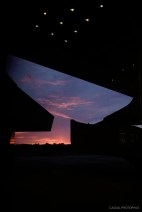Consumer bias is a tricky thing. Once you’ve bought something, you don’t want to admit you’ve made the wrong choice, and just as often you’d like to believe that others have made the wrong choice in order to support your newfound bias. This is how we wind up with Ford loyalists and Buffalo Bills fans.
Those who buy cameras are no different. Buying into a system is expensive, and for many of us camera owners, our camera is among the most expensive consumer goods we own. I used to drive an ancient Saab 900 I found on Craigslist, and I liked to joke that the easiest way to double its value was to set my camera on the passenger seat. It’s no wonder that we spend so much time reading reviews and fretting over how we spend our camera budget.
At around $900 new in box, the Fujifilm XF 16mm f/1.4R WR is an incredibly specialized lens that buyers may have a hard time justifying. It costs about $56 per millimeter of focal length, or about $64 per character in its model name. That seems pretty good. Canon’s most comparable lens, the Canon EF 24mm f/1.4L II USM, costs a bit more per millimeter and a bit less per letter. I’m not sure if this totally arbitrary metric makes the Fuji a good value, but it does feel like quite a bit of lens for the money. And if you like a fairly wide lens (an equivalent 24mm on full frame) the XF 16mm f/1.4R WR has a lot going for it.
Optical construction is fairly complex, with 13 elements in 11 groups, two aspherical elements, and two dispersion-reducing elements. It’s also weather resistant, which is handy if you own one of Fuji’s weather sealed bodies. This technical complexity allows the XF 16mm to compete in image quality with other wide-angles from world-class brands, but it also makes the lens quite large. This 16mm lens towers over Fuji’s long-time standard kit lens, the XF 18-55mm. This monumental girth means it doesn’t quite cop to the X-system’s tyical compactness. It also outweighs the kit lens, and it doesn’t offer image stabilization. Of course, with its extremely fast maximum aperture and slick ergonomics, you may not notice the lack of stabilization.
Fujifilm is weirdly inconsistent with how their lenses operate. Some lenses with aperture rings have marked apertures. Some are unmarked and can be spun freely when the camera is in control of the aperture. Some lenses have depth of field scales near the focus ring. Some do not. These odd design differences can often mean the difference between a decent Fuji lens, and a true masterpiece of modern glass. Happily, the 16mm pulls more from the latter, as it combines almost all of Fuji’s good ergonomic ideas into a single lens.
The aperture ring is clearly marked with white numerals, and a reddish “A” for the camera-selected aperture setting. The focus ring uses a clever clutch-type system to engage and disengage manual focus in which the whole focus ring slides fore and aft along the length of the lens to change the focusing method. When in autofocus mode, the ring does not turn. When in manual focus mode, it turns smoothly with enough resistance that small bumps won’t foul your focusing. Of course, focusing is all internal and handled electrically, so that lovely resistance does not reflect on any mechanical action, which is always a shame.
In the hand, the lens feels wonderful, if a bit heavy. Of course, its 375g weight comes from the simple fact that it’s packing a lot of glass. Ergonomically my only real complaint is that the weather-sealing gasket made mounting the rear lens cap a bit tricky. Of course, if the lens simply stays on the camera for extended periods, this is a non issue.
All this said, a lens is meant to be shot, not fondled. In this context I found the XF 16mm extremely useful, if a bit flawed. Living in New York and using this lens in November meant spending a lot of time shooting in the dark. If I wanted to shoot on a weekday, the day’s commitments meant that it was going to be dark out when it came time to shoot. The extremely fast maximum aperture effectively extended my shooting day, without forcing me to resort to noisy, high ISOs.
Shot wide open, the XF 16mm is very, very sharp on center. Indeed, to date I’ve not used a Fuji lens that wasn’t tack sharp at the center wide open. However, things do come a bit unglued at the edges. If you’re shooting in high light, the corners and edges will suffer some chromatic aberrations, and some purple tinges. As you would expect, stopping down improved corner to corner sharpness. Past about f/4 the lens became sharp across the whole image. If shot in darker spaces, where the fast aperture is most useful, these wide open issues are much less apparent.
Focusing was problematic. The autofocus was easily fooled, and often struggled to focus accurately. Out of sheer frustration I often found myself switching to manual focus. To date I’ve shot quite a few Fujinon lenses, and this felt like the worst autofocus of the lot. Manual focusing is excellent, contrary to what many people say about Fuji’s focus-by-wire system. Even shot wide open the depth of field is quite deep when focusing on subjects more than five feet or so away, which makes manual focus very easy.
Image quality is very good. Fuji seems to have spent a lot of effort ensuring that all of their lenses have very similar color rendition and offer similar levels of contrast. Unsurprisingly, the colors are vivid, and straight out of the camera images feel punchy and vibrant. It’s a very likeable lens. I was always pleased to be using it, warts and all.
Bokeh is oddly pleasant for a wide-angle lens. Though backgrounds aren’t the sheer sheet of blur we see from fast lenses of longer focal lengths, with its incredibly close focusing distance of 15 cm, close-up subjects are isolated well enough. It’s certainly not the lens’ raison d’etre, but it’s nice to know we can coax acceptable bokeh from a 24mm equivalent. Just don’t try to shoot flattering portraits with it – not possible.
As much as I enjoyed this lens, I can only see a couple of reasons one might buy it over the two most similar lenses in Fuji’s lineup; the XF 18mm f/2.0 and the XF 14mm f/2.8R, both of which are less expensive than the 16mm. The XF 18mm is extremely compact, which I value, and the XF 14mm is excellent in nearly every way. But both of those lenses are slower than the 16mm, so if absolute speed is your ultimate measure, there’s nothing to beat the XF 16mm f/1.4 in Fuji’s wide angle lineup. If you own an X-Pro 2 or X-T2 and require weather sealing, the other two wide angle lenses can’t hang.
But if you don’t need a weather-sealed, ultra-fast wide lens, this may not be the best fit. The good news is that in Fuji’s quest to make the X-series a camera system that no one will regret buying, they’ve made a lens for every need. I certainly don’t want to imply that the XF 16mm is a bad lens. Even with its faults, the XF 16mm f/1.4R WR stands upright on its own merits and can hold its head high. If its particular set of skills satisfy your needs as a shooter, it will quickly make itself irreplaceable.
Want the Fuji 16mm?
Get it from B&H Photo
Follow Casual Photophile on Facebook and Instagram
[Some of the links in this article will direct users to our affiliates at B&H Photo, Amazon, and eBay. By purchasing anything using these links, Casual Photophile may receive a small commission at no additional charge to you. This helps Casual Photophile produce the content we produce. Many thanks for your support.]





























Chris, I always look forward to reading the articles on CP. Usually w my morning coffee. Today I have agita. Ford Loyalists? I know not a lot about camera stuff (although I am learning here), but I do know trucks. There’s Ford then the rest. Sorry you may drive something else. You write well on subjects pertaining to this site. I agree with the Bills comment though. Good job.